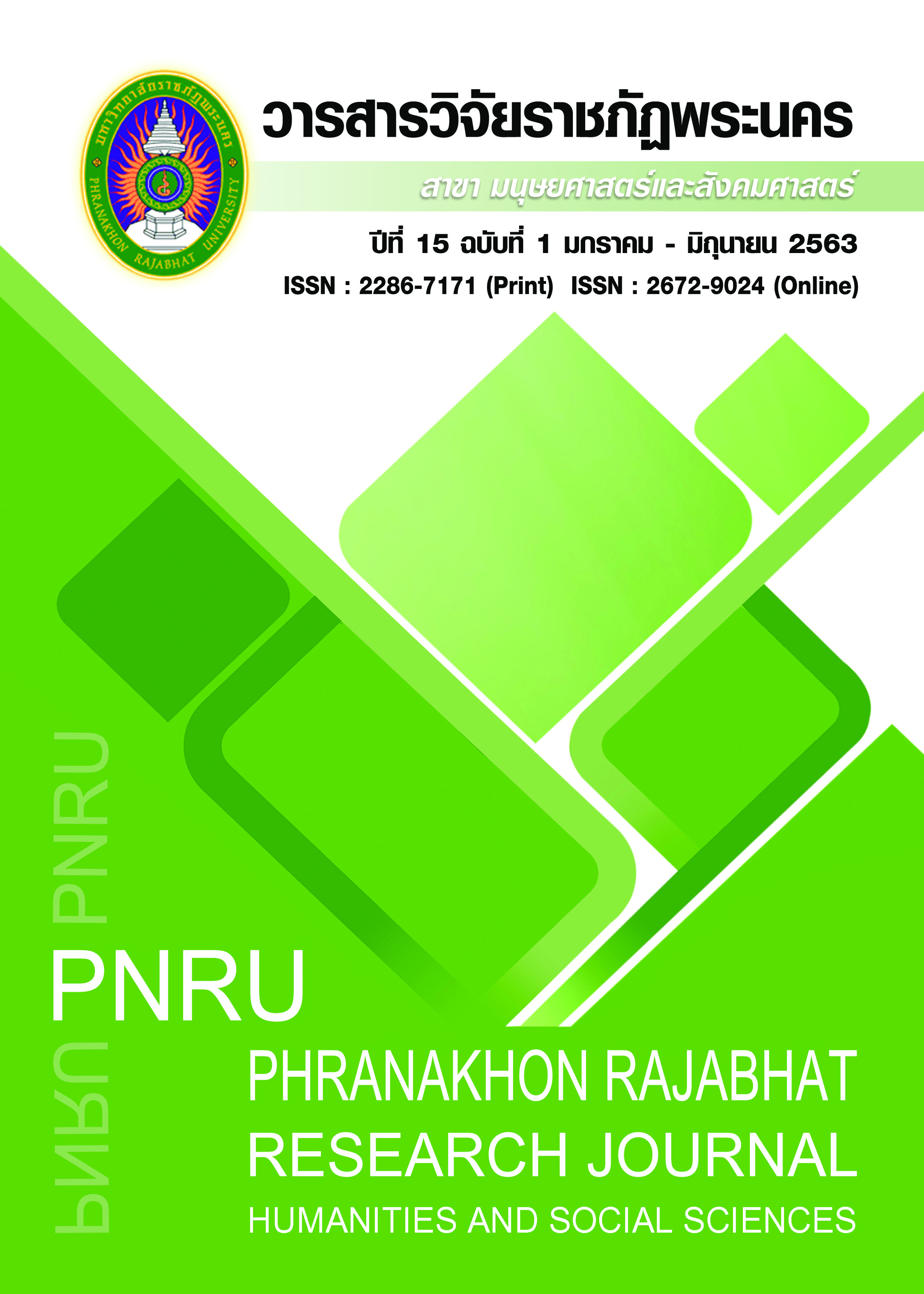การสื่อสารระหว่างวัฒนธรรมด้านค่านิยมองค์กรของมหาวิทยาลัย ราชภัฏบ้านสมเด็จเจ้าพระยาผ่านมุมมองด้านมิติทางวัฒนธรรม
Main Article Content
บทคัดย่อ
การวิจัยนี้มีวัตถุประสงค์เพื่อศึกษาการสื่อสารระหว่างวัฒนธรรมด้านค่านิยมองค์กรของบุคลากรมหาวิทยาลัยราชภัฏบ้านสมเด็จเจ้าพระยาผ่านมิติทางวัฒนธรรม กลุ่มตัวอย่างที่ใช้ในงานวิจัยมีจำนวนทั้งสิ้น 278 คนได้มาจากการผู้บริหาร อาจารย์ และ นักวิชาการ/เจ้าหน้าที่ เครื่องมือที่ใช้ในการวิจัย คือ แบบสอบถาม สถิติที่ใช้ในการวิจัย ได้แก่ ร้อยละ ค่าเฉลี่ย ส่วนเบี่ยงเบนมาตรฐาน ผลการวิจัยพบว่า การสื่อสารระหว่างวัฒนธรรมด้านค่านิยมองค์กรของมหาวิทยาลัยราชภัฏบ้านสมเด็จเจ้าพระยาผ่านมุมมองด้านมิติทางวัฒนธรรมประกอบด้วย 8 ด้าน คือ 1) ค่านิยมด้านคุณธรรมผ่านมิติทางวัฒนธรรมด้านความสำคัญของความเป็นบุรุษ 2) ค่านิยมด้านวินัยผ่านมิติทางวัฒนธรรมด้านระยะห่างเชิงอำนาจมาก 3) ค่านิยมด้านความผิดชอบผ่านมิติทางวัฒนธรรมด้านคติรวมหมู่ 4) ค่านิยมด้านความรักในองค์กรผ่านมิติทางวัฒนธรรมด้านคติรวมหมู่ 5) ค่านิยมด้านความเอื้ออาทรแบ่งปันผ่านมิติทางวัฒนธรรมด้านการกำหนดแผนระยะเวลาในอนาคตระยะยาว 6) ค่านิยมด้านการสร้างสรรค์นวัตกรรมผ่านมิติทางวัฒนธรรมด้านการหลีกเลี่ยงความไม่แน่นอนสูง 7) ค่านิยมด้านการทำงานเป็นทีมผ่านมิติทางวัฒนธรรมด้านความสำคัญของความเป็นบุรุษ และ 8) ค่านิยมด้านความสำเร็จผ่านมิติทางวัฒนธรรมด้านการหลีกเลี่ยงความไม่แน่นอนสูง
Article Details
บทความที่ได้รับการตีพิมพ์เป็นลิขสิทธิ์ของมหาวิทยาลัยราชภัฏพระนคร
ข้อความที่ปรากฏในบทความแต่ละเรื่องในวารสารวิจัยราชภัฏพระนครเล่มนี้เป็นความคิดเห็นส่วนตัวของผู้เขียนแต่ละท่านไม่เกี่ยวข้องกับมหาวิทยาลัยราชภัฏพระนคร และคณาจารย์ท่านอื่นๆในมหาวิทยาลัยฯ แต่อย่างใด ความรับผิดชอบองค์ประกอบทั้งหมดของบทความแต่ละเรื่องเป็นของผู้เขียนแต่ละท่าน หากมีความผิดพลาดใดๆ ผู้เขียนแต่ละท่านจะรับผิดชอบบทความของตนเองแต่ผู้เดียว
เอกสารอ้างอิง
กองบริหารงานบุคคล. (2561). สถิติบุคลากรทุกประเภท มหาวิทยาลัยราชภัฏบ้านสมเด็จเจ้าพระยา ณ วันที่ 5 มกราคม 2561. เข้าถึงเมื่อวันที่ 15 มกราคม 2561 จาก http://person.bsru. ac.th/4sathiti.php
ช.ปวินท์ เพ็ชญไพศิษฏ์. (2557). การสื่อสาร วัฒนธรรมองค์กร และความไว้วางใจกัน ที่มีอิทธิพลต่อการทำงานเป็นทีมของพนักงานรัฐวิสาหกิจด้านพลังงานไฟฟ้าแห่งหนึ่งในเขตกรุงเทพมหานคร. (บริหารธุรกิจมหาบัณฑิต), มหาวิทยาลัยกรุงเทพ.
ณัฐธิดา เกือเจ. (2557). การสื่อสารข้ามวัฒนธรรม. Retrieved from https://destinymetoo. wordpress.com/culture/
ณัฐธิดา ชูเจริญพิพัฒน์. (2555). วัฒนธรรมในองค์กรที่มีผลต่อการปฏิบัติงานของพนักงานธนาคารไทยพาณิชย์ เขตนครสวรรค์. (ปริญญาบริหารธุรกิจมหาบัณฑิต), มหาวิทยาลัยเทคโนโลยีราชมงคลธัญบุรี. Retrieved from http://www.repository.rmutt.ac.th/bitstream/ handle/123456789/2168/Binder1.pdf? sequence=1
ณัฐวรรณ พุ่มดียิ่ง. (2558). วัฒนธรรมองค์การของมหาวิทยาลัยราชภัฏ. Journal of Thai Interdisciplinary Research, 10(1), 66-77.
ธนกฤต สังข์เฉย. (2555). ความแตกต่างทางมิติวัฒนธรรมกับพฤติกรรมนักท่องเที่ยว. วารสารมนุษยศาสตร์และสังคมศาสตร์ มหาวิทยาลัยมหาสารคาม, 31(5), 61-72.
บุญศรี พรหมมาพันธุ์. (2558). เทคนิคการแผลผลการวิเคราะห์ข้อมูลสำหรับการเปรียบเทียบค่าเฉลี่ยในการวิจัย. วารสารศึกษาศาสตร์ มสธ., 8(2), 24-40.
แผนกลยุทธ์มหาวิทยาลัยราชภัฏบ้านสมเด็จเจ้าพระยา พุทธศักราช 2558-2562 (ฉบับปรับปรุง). (2559). กรุงเทพฯ: มหาวิทยาลัยราชภัฏบ้านสมเด็จเจ้าพระยา.
พนิดา จงสุขสมสกุล. (2559). การสื่อสารระหว่างประเทศและการสื่อสารระหว่างวัฒนธรรมในสมัยสมเด็จพระนเรศวรมหาราช. วารสารภาษาและวัฒนธรรม, 35(พิเศษ).
พัชราภา เอื้ออมรวนิช. (2560) การสื่อสารภายใต้มิติความหลากหลายทางวัฒนธรรมตามแนวคิด Geert Hofstede. วารสารวิชาการมนุษยศาสตร์และสังคมศาสตร์, 25(47), 1-18.
เมตตา วิวัฒนานุกูล (กฤตวิทย์). (2559). การสื่อสารระหว่างวัฒนธรรม. (พิมพ์ครั้งที่ 2). กรุงเทพฯ: จุฬาลงกรณ์มหาวิทยาลัย.
เมทินี คงเจริญ และอัญชนา พานิช. (2561). วัฒนธรรมองค์กรที่ส่งผลต่อการปฏิบัติงานตามมาตรฐานวิชาชีพของพนักงานครูในสถานศึกษาสังกัดองค์กรปกครองส่วนท้องถิ่นจังหวัดเพชรบุรีและจังหวัดประจวบคิรีขันธ์. Veridian E-Journal, Silpakorn University, 11(3), 2443-2457.
ลินดา เกณฑ์มา. (2559). ประกาศมหาวิทยาลัยราชภัฏบ้านสมเด็จเจ้าพระยา เรื่อง เจตจำนงสุจริตในการบริหารงานด้วยคุณธรรมและความโปร่งใสของมหาวิทยาลัยราชภัฏบ้านสมเด็จเจ้าพระยา. Retrieved from http://www.bsru.ac.th/news/archives/2164
เอกสิทธิ์ เข้มงวด. (2557). การศึกษาเปรียบเทียบมิติทางวัฒนธรรมระหว่างไทย-ญี่ปุ่น กรณีศึกษาบริษัทญี่ปุ่นในประเทศไทย. รายงานการวิจัย. คณะบริหารธุรกิจ. สถาบันเทคโนโลยีไทย-ญี่ปุ่น. ประเทศไทย. Retrieved from http://ba.tni.ac.th/new/upload/files/ Research_Ekkasit1.pdf
Berdie, D. R., Anderson, J. F., & Niebuhr, M. A. (1986). Questionnaires: Design and Use. Metuchen, N.J.: Scarecrow Press.
Best, J. W. (1981). Research in Education. New Jersey: Prentice-Hall.
Hofstede, G & Hofstede, G. (2005). Cultures and Organizations: Software of the mind. Revised and Expanded. (2nd edition). USA.: McGraw-Hill.
Hofstede, G. (1984). Culture’s consequences: international differences in work-related Values. (Abridged ed.). Beverly Hills, CA: Sage Publications.
Hofstede, G. (2013). Cultural Values 2013. Retrieved from geerthofstede.com/wp-content/.../VSM-2013-Thai-2015-05-31.doc
Krejcie, R. V. & Morgan, D. W., (1970). Determining Sample Size for Research Activities, Educational and Psychological Measurement.
Minkov, M. (2013). Cross-Cultural Analysis: The Science and Art of Comparing the World's Modern Societies and Their Cultures. The U.S.: SAGE.
Smith, P., & Riley, A. (2009). Cultural Theory. (2nd ed.). The U.S.: Blackwell.
Spitzberg, B. H., & Changnon, G. (2009). Conceptualizing Intercultural Competence. In D. K. Deardorff (Ed.), The SAGE Handbook of Intercultural Competence. California: SAGE.
Ting-Toomey, S., & Chung, L. (2012). Understanding Intercultural Communication. (2nd ed.). New York: Oxford University Press.
Waisfisz, B. (2012). An organisational cultural perspective. The Hofstede Centre: Strategy - Culture - Change. Retrieved from https://geerthofstede.com/tl.../ art%20organisational%20culture%20perspective.pdf


